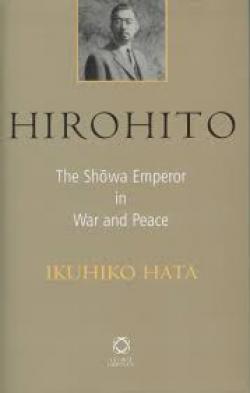Hirohito: The Showa Emperor in War and Peace

ISBN 978-1-905246-35-9, pages 272 including notes and index, Global Oriental, 2007.
Review by Sir Hugh Cortazzi
So much has been written about the Showa Emperor that some readers may ask whether there is anything more to be said about a man who would hardly have left much lasting impression if he had been born in any other walk of life. But Professor Ikuhiko Hata’s book provides some interesting insights into the emperor’s personality, as well as into aspects of modern Japanese history.
Professor Ikuhiko Hata, professor emeritus of Nihon University, has delved deeply into the source material available in Japanese and English and has interviewed many of the participants in the events he describes. The results of his researches impressed the late Professor Marius Jansen, a doyen of Japanese historical studies in the USA, and we must be grateful to him and the publishers, Global Oriental, for bringing these fascinating studies to the attention of English speaking students of modern Japanese history.
This is not a new biography of the Showa Emperor but a series of historical studies of events in which he was closely involved. The first essay deals with the infamous ni-ni-roku (26 February 1936) incident when the emperor’s adamant refusal, following the murder of some of his closest advisers, to countenance a “Showa Restoration” as demanded by the rebels, ensured that the mutiny was crushed. But as Professor Hata puts it: “From the emperor’s perspective, the mountain had laboured and produced a mouse. Hegemony had merely passed from the hands of the Imperial Way Faction into the hands of the Control Faction and its epigones and Japan would soon plunge headlong down the path to destruction in the China and Pacific Wars.” Hata’s account fills in many details and gives a vivid picture of how the events must have seemed to those at the centre of the crisis.
The second chapter goes over the events in the final days of the Pacific War and describes how the emperor was eventually induced to take the decision which led to Japan’s surrender. It also depicts the reactions of the military and naval extremists and the traitorous attempts to stop the emperor’s broadcast. Inevitably it leaves many questions unanswered. Why in particular did it take so long for intelligent men (and many of Japan’s leaders were intelligent and realistic) to recognize that Japan was defeated. This should have been obvious at the latest by the end of 1944. Yet they adhered to the belief that Japan’s “polity” (a concept which non-Japanese find hard to fathom) could only be preserved by fighting a last battle on the mainland which could only lead to total destruction. Their failure makes them guilty of the millions of deaths caused by the continuing war in the months from January to August 1945. The emperor seems to have recognized that Japan faced total defeat, but his personality was not strong enough to enable him to challenge the guilty men. We also have to ask how much he knew about the atrocities carried out overseas and if he did realize the facts why he apparently did not attempt to stop further acts of barbarity.
The third chapter reveals the extent to which in the final days of the war and the early days of the occupation attempts were made by Japanese extremists to ensure the survival of the imperial line. Many of the facts revealed here were new to me. They confirm that the occupation authorities were right to be wary of the former militarists.
The final chapters deal with the emperor’s relations with General MacArthur and the possibility of the emperor abdicating, a step which the General regarded as unnecessary and undesirable. MacArthur and his advisers clearly saw the retention of the emperor as essential to the maintenance of internal peace in Japan.
Hata also deals with the emperor’s position in relating to the International Military Tribunal’s trial of class A war criminals. This section is relevant to recent revelations about the emperor’s criticism of the decision by the Yasukuni shrine authorities to enshrine the souls of these criminals.

